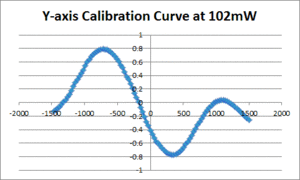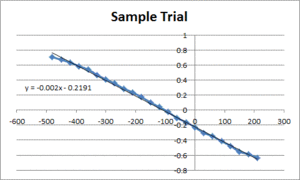Difference between revisions of "ThorLabs OTKB optical trapping kit"
(→Methodology) |
|||
| Line 16: | Line 16: | ||
#Prepare a sample cell per section 3.5 of the [http://scripts.mit.edu/~20.309/wiki/images/2/27/Optical_Trapping_Lab_Manual.pdf Optical Trapping Lab Manual]and load it with stuck and suspended silica microspheres as per section 4.1.1. | #Prepare a sample cell per section 3.5 of the [http://scripts.mit.edu/~20.309/wiki/images/2/27/Optical_Trapping_Lab_Manual.pdf Optical Trapping Lab Manual]and load it with stuck and suspended silica microspheres as per section 4.1.1. | ||
#Trap a suspended microsphere and adjust the focus to place it near the middle vertically of the sample cell. (Crash the trapped bead into the coverslip and then raise it abaout half of the height of the cell, which is about 100 microns.) | #Trap a suspended microsphere and adjust the focus to place it near the middle vertically of the sample cell. (Crash the trapped bead into the coverslip and then raise it abaout half of the height of the cell, which is about 100 microns.) | ||
| − | #Using QPD Alignment Tester, adjust the QPD position | + | #Using QPD Alignment Tester, adjust the QPD position until the voltage output on both axes is near zero. |
| + | #Save an image of the trapped bead. | ||
#Find a stuck bead. | #Find a stuck bead. | ||
#Adjust the focus so that the stuck bead looks similar to the saved image of the free trapped bead. | #Adjust the focus so that the stuck bead looks similar to the saved image of the free trapped bead. | ||
Revision as of 12:51, 7 July 2010
OTKB construction
Modifications to ThorLabs suggested layout
Alignment procedure
Comparison of OTKB and 20.309 optical trap operating characteristics
Position calibration
The position calibrations determine the sensitivity of the quadrant photodiode detector to changes in position of a bead. Accurate quantitative results depend on precise position calibration.
Methodology
- Prepare a sample cell per section 3.5 of the Optical Trapping Lab Manualand load it with stuck and suspended silica microspheres as per section 4.1.1.
- Trap a suspended microsphere and adjust the focus to place it near the middle vertically of the sample cell. (Crash the trapped bead into the coverslip and then raise it abaout half of the height of the cell, which is about 100 microns.)
- Using QPD Alignment Tester, adjust the QPD position until the voltage output on both axes is near zero.
- Save an image of the trapped bead.
- Find a stuck bead.
- Adjust the focus so that the stuck bead looks similar to the saved image of the free trapped bead.
- Center the bead as per section 4.1.2. and run the Position Calibration VI. In the data file, the first row gives displacement from the starting position (in nm) and the second row gives the QPD signal (in V). WHAT ABOUT THE THIRD ROW?
- Fit a line to the approximately linear portion of the graph where the bead passes through the center of the trap. The slope of the line is the position sensitivity in V/nm.
- Repeat 5 times on 5 different stuck beads.
- Use the same procedure on the other axis
- Repeat the entire process at 5 power levels
- Compute the average sensitivity and standard deviation at each power level. Fit a line and plot to facilitate interpolation.
Materials
- 1μm silica microspheres, BangsLabs SS03N/4669
- 25x75mm glass slide
- 22x40mm #0 coverslip
- 1M NaCl
Calibration
The X and Y axis calibrations were performed in the following manner:
Sources of error
1. Accuracy of picomotor travel (for this experiment, the stage movement for this calibration was not 100% unidirectional)
2. Focus of bead - since the beads can't be trapped, we don't know if they are in the center of the trap with respect to the z-axis. This could affect the voltage signal.
Results
| ThorLabs OTKB | 20.309 | |
|---|---|---|
| X position | TBD | 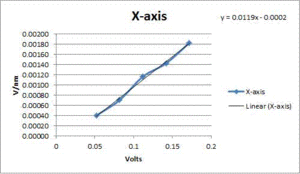
|
| Y position | TBD | 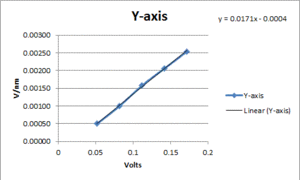
|
Trap stiffness
The force calibrations determine the stiffness of the trap. The stiffness of the trap characterizes the forces exerted by it. Three different methods were used in order to determine the stiffness of each trap: Equipartition, noise PSD roll-off, and Stokes drag.
Methodology
Equipartition
For small displacements from the center of the trap, the trap is considered to be like a spring. The Equipartition method of calculating trap stiffness centers around relating the variance in a trapped object's position due to thermally induced position fluctuations. From the Equipartition Theorem, every degree of freedom in a harmonic potential will contain $ \frac{1}{2} k_B T $ of energy, where $ k_B $ is Boltzmann's constant and T is the absolute temperature. Since the trap acts as a spring, we can equate this energy to the potential energy stored in the 'spring': $ \frac{1}{2} \alpha \left \langle \Delta x^2 \right \rangle $, where $ \alpha $ is the trap stiffness and $ \left \langle \Delta x^2 \right \rangle $ is the variance in position. Solving for $ \alpha $, we get: $ \alpha = \frac{k_B T}{\left \langle \Delta x^2 \right \rangle} $. Assuming these experiments are being run at room temperature, this equation simplifies to: $ \alpha = \frac{4.1124*10^-21}{\left \langle \Delta x^2 \right \rangle} $. Thus, in order to solve for the trap stiffness, the variance in position is the only thing that needs to be calculated. However, since this variance is measured in volts, position calibrations will be required in order to convert the voltage signal into a position in meters (note: since the calibration values from the previous section were in V/nm, you will need to convert these into V/m in order to solve for $ \alpha $). The next section will explain the procedure used to perform this force calibration.
Procedure
1. Using the methods discussed in the Position Calibration procedure, make a slide and load a 1:50,000 dilution of 10% wt stock beads (1 μm silica, Bangs, SS03N/4669) in its channel.
2. Load the slide onto the microscope and trap a bead. Raise the bead to the middle of the slide and move it away from any obstructions. Open the QPD Alignment Tester VI and make sure that the voltage signal is centered at 0 (if it is not, adjust the screws on the QPD so that the signal rests at 0)
3. Open the WriteXYTraceToFile VI. Select which channel you would like to sample from (for this experiment, dev1/ai0 corresponded to the X-axis and dev1/ai1 corresponded to the Y-axis). Enter the Sampling rate in Hz and the sampling time in seconds (for this experiment, 64000 and 3 were used respectively). Start the VI. While the VI is running, carefully watch the IC capture of the slide to make sure that neither the bead leaves the trap nor something else becomes trapped. If either of these things happen, you should discard the data for that trial.
4. Save the data, and load them into an analysis software (Matlab was used for this experiment). Using this software, calculate the variance of the data. The answer given will be in Volts. In order to convert this to meters, divide by your calibration factor squared (NOTE: THE CALIBRATION FACTOR NEEDS TO BE IN V/M AND NOT V/NM AS YOU MEASURED IT!). Finally, using the equation stated in the introduction to this method, calculate your trap stiffness. This answer will be in Newtons per Meter. Since trap stiffnesses are usually measured in picoNewtons per nanoMeter, multiply your result by 1000 to get the right magnitude for those units.
5. As with the position calibration, make sure you run multiple trials for each axis and power level and average the results (depending on the variance of your results, you may wish to take the median of all trials instead of the mean).
6. For each axis and power level, plot the trap stiffness versus the power level. Fit these data to a line. If this calibration and the position calibration were done carefully, the linear fit should be quite accurate.
Possible Sources of Error
1. This calibration requires extremely accurate position calibrations in order to yield accurate data
2. This calibration is very sensitive to noise.
Results
Equipartition
| ThorLabs OTKB | 20.309 | |
|---|---|---|
| X and Y axes | TBD | 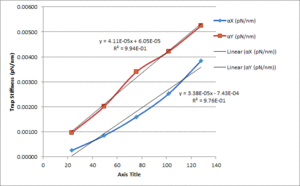
|
